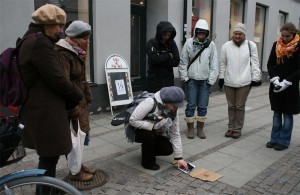The Sustainable City Walks have begun. These walks, arranged by the organization Lund Students for Sustainability, are aimed at getting students to engage in more sustainable shopping methods that save money and protect the environment.
On a typical cold and windy February afternoon, a group of seven Lund students decided to beat out the weather to follow Anja Humburg, Joanne Perry, and Ulrika Tegnér down Stora Södergatan on a crusade: a crusade to inform people about how their decisions affect the world at large.
In glasses, a dark coat, and a blue scarf, Christiane, one of the participants, held up a bright blue and green inflatable globe as she walked.
And, as one would expect, this special, highly interactive tour for international students was focused on environmentally friendly shopping strategies.
Where do jeans come from?
First stop of the day was a fabric store. Anja Humburg, one of the leaders of the project, asked everyone: “How many clothes do you have at home?” A true challenge for those with preferences for fashion.
The question also came up: “Do any of you know where your jeans actually come from?” The answer wasn’t in a store on the street, but on the little globe that Christiane was holding onto earlier.
She pointed to a little country somewhere in Eastern Asia, a stark reminder that our jeans don’t sew themselves.
Expensive advertising
At one stop, Anja asked the group yet another pressing question: “How much did the shoes you are wearing today cost?”
The answers ranged between roughly 70 SEK for a pair of second-hand boots, to a hefty 1 350 SEK for a pair of quality hiking boots.
Joanne Perry continued by laying a diagram of a cardboard shoe cut up into a few different sections. “So,” the women asked, “Where do you think 50 percent of the money you paid for your shoe goes?” As the group found out that day, 50 percent goes to advertising, while just a measly 2 percent goes to the dirt-poor individual in a sweatshop, halfway across the globe.
Food, Paper, and Hot Tea
During the remainder of the walk, they went through discussions about what kind of food to buy, where to buy it, and then a quick run-through on how paper production also causes heavy CO2 emissions.
A cozy lounge at the ABC store was waiting, where we were invited to free chocolates and hot tea – perhaps a perfect close to an icy cold day. And the message of the tour was crystal clear, as we were given names of organic food stores, environmentally accredited clothing chains, and socially conscious places to shop: this is how you can go green in Lund.
“We are really about trying to find the most sustainable places to shop in Lund, and letting the university students know about where they can make conscious shopping decisions,” says Joanne Perry, one of the organizers of Sustainable City Walks, and also a key member of Lund Students for Sustainability.
Shopping Methods
“Recycling electronics and clothes is probably the best way of upholding sustainability. Buying second-hand clothes is one of the best ways for one to keep freedom of choice while still maintaining a way of thinking directed towards the environment,” explained Ulrika Tegnér, another active member of HU.
And so, the question was posed, “Am I going to have to buy shoes that are ugly in order to be eco-friendly?”Well, according to the makers of Sustainable City Walks, it doesn’t have to be that way.
“You can still find beautiful (and fashionable) shoes and clothes even at a second-hand store,” says Joanne Perry.






